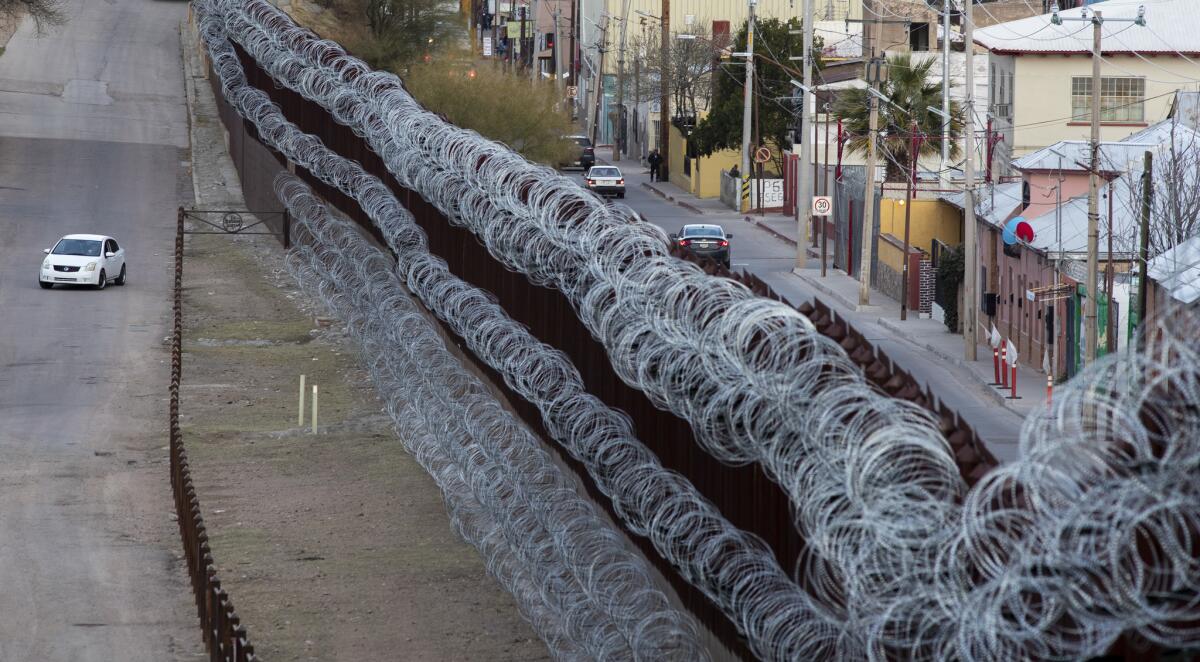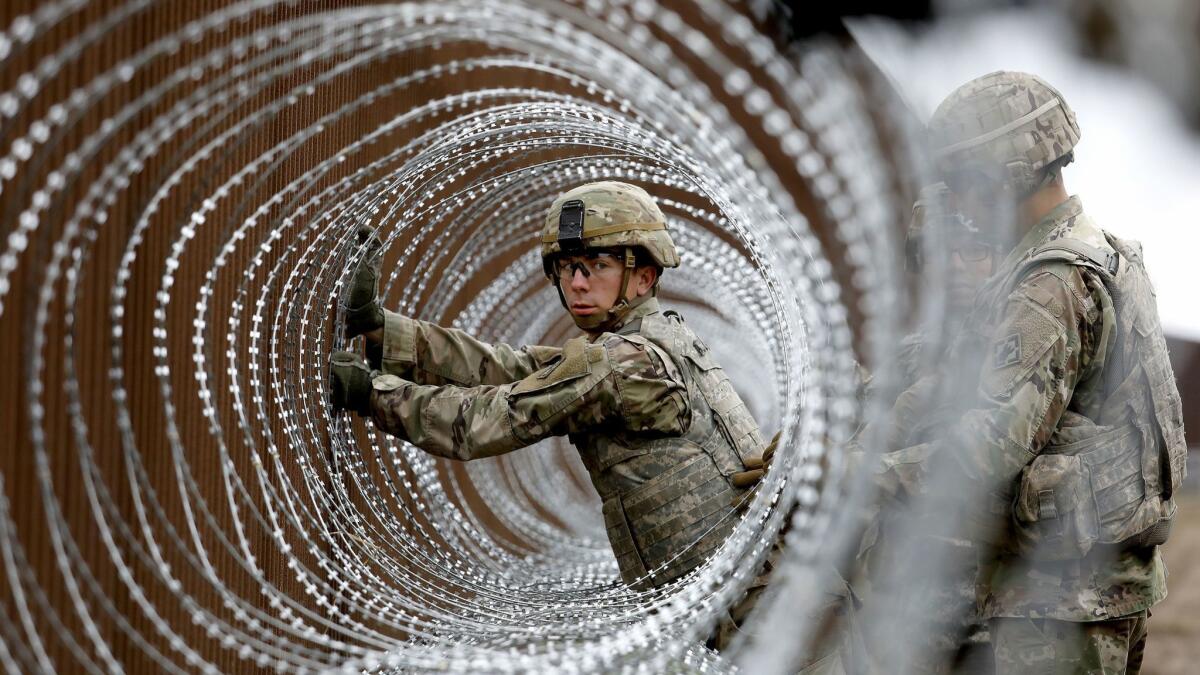Trump says barbed wire ‘can be a beautiful sight.’ Many border communities disagree

- Share via
Reporting from Nogales, Arizona — Most people know it as razor wire.
It coils atop the walls and fences that divide the U.S. and Mexico, snaking through weeds and past traffic signs, splintering the sunlight with its shiny knife-like barbs.
For the record:
1:45 p.m. March 25, 2019This article indicates the Border Patrol asked the military to install 350 miles of wire and that troops had about 180 miles to go. A military spokesman says the agency asked for the installation of 210 miles of wire and that troops had a few miles to go.
The U.S. military prefers a less menacing name: concertina wire.
Troops on the southern border have installed hundreds of miles of the wire during the last few months as part of President Trump’s effort to stop caravans of Central American migrants from entering the country.
“Barbed wire, used properly, can be a beautiful sight,” Trump said to cheers at a rally in Montana in November.
But many U.S. communities along the border strongly disagree. Border city leaders and other officials argue that the wire is better suited to war zones and prisons and that any benefit is not worth the damage it is doing to their images or the threat it poses to wildlife, livestock and people.
“We don’t like to see concertina wire anywhere unless there’s imminent danger,” said Laredo, Texas, Mayor Pete Saenz.
The troops, which were deployed to the southwest border in October, unfurled about a mile of the wire near two bridges in Laredo in anticipation of a migrant caravan that never arrived.
“It makes you wonder,” Saenz said. “Are we overreacting?”
At the city’s request, the Border Patrol instructed the troops to take down the wire.
They left some coils of wire behind, Saenz said, “in the event there’s another caravan.”
In December, Rep. Vicente Gonzalez (D-Texas), whose district includes part of the Rio Grande Valley, complained in a letter to the Border Patrol commissioner that the wire had contributed to the “militarization of our border.”
The Border Patrol said in a statement Friday that the wire has been used along the border in the past and is working now.
In places where the wire was recently installed, the number of migrants caught crossing the border has dropped dramatically, the statement said.
“Officials have already seen the effectiveness of the additional strands of wire,” it said, touting the benefits of placing several strands of razor wire side by side.
“Previously, criminal organizations posted individuals on the Mexican side of the border to scout and cut wire installed on the top tier of the fence,” the statement said. “Once removed in sections, human smugglers would exploit the opening and send individuals over illegally into the U.S. The new multi-layered wire prevents individuals from using this tactic.”
The Border Patrol does not track wire-related injuries, but the agency said the wire deters people from trying to scale border barriers, which is a common cause of broken ankles and other injuries.

The wire — supplied by Allied Tube and Conduit of Hebron, Ohio, under a $41-million contract with the Department of Defense — is also popular with conservative groups that lobby for increased border enforcement.
“It’s another barrier, another thing in the way to slow people down,” said Jessica Vaughan, director of policy studies at the Center for Immigration Studies in Washington.
Vaughan said the wire could be used to quickly fortify weak spots along “outdated” border fences and that it deterred deportees trying to sneak back into the country as opposed to migrant families seeking asylum at the border.
“It’s not a silver bullet, but it does help,” she said.
The Border Patrol has asked the military to install 350 miles of wire. The troops have about 180 miles to go, according to Maj. Mark Lazane, a spokesman for U.S. Northern Command.
Of the 4,000 troops now on the border, 1,850 are involved in the effort, which is currently limited to Arizona and California, Lazane said.
“Once emplaced, the concertina wire barrier becomes the property of [Border Patrol], including any decision to move or remove it,” he said.
The Border Patrol said it has no plans to remove wire that has been erected in recent months. But pressure has been growing to do just that.
Jesus “Jesse” Morales, the fire chief in Naco, Ariz., worried that his 16 volunteer firefighters, including three paramedics, could get hurt rescuing someone from the concertina wire.
“We’re just waiting for something to happen,” he said. “To me, it’s a ticking time bomb.”
About four years ago in Naco, a young girl fell off a 14-foot-high border fence, landed on a pile of wire and was cut so badly she had to be taken to a hospital in Tucson, Morales said.
Last month, residents of the 14,000-person town gathered at the border crossing to protest the wire and demand its removal.
Other opponents of the wire expressed concern that animals could get caught up in it.
The Center for Biological Diversity in Tucson has documented spots in the Rio Grande Valley where wire was spread through brushland.
“There’s not a single document that we’ve turned up — and we’ve done a lot of research — that shows any strategy, any consideration for wildlife,” said Laiken Jordahl, a campaigner with the group.
“We saw it just staked into the ground in places where it’s near irrigation canals or the river where the environmental impacts are potentially severe,” he said. “It can ensnare wildlife.”
In McAllen, Texas, Mayor Jim Darling said the city deemed some of the newly placed wire unnecessary and took it upon itself to remove it. “We’re secure,” he said. “Our cities are safe.”
In some places, troops strung wire perpendicular to the Rio Grande, the meandering line between Mexico and the U.S.
“In fairness to the military, it’s hard to tell where the border is,” Darling said.
But the wire made things more confusing.
“We didn’t know if they were trying to fence people in or out,” he said.
In the Arizona border city of Nogales, Mayor Arturo Garino demanded a meeting with Border Patrol officials last month after troops started posting concertina wire along the sides of the fence through downtown.
“They didn’t want to talk to me,” he said.
Garino met with local police and fire chiefs, who didn’t like the concertina wire either.
“They were concerned about the first responders having to go if someone was to fall into it, one of the citizens on our side or somebody trying to jump over,” Garino said.
A week later, he and the chiefs met the local Border Patrol chief, who told them the wire was meant “to fortify the area.”
When Garino asked why, he said, the Border Patrol commander told him: “Because we’re having rapists, murderers and child molesters jump over the wall.”
The mayor walked out of the meeting. “I couldn’t believe that was their explanation,” he said.
The Border Patrol said in its statement that it has taken various measures to protect people from the wire around Nogales. Those include adding fences and warning signs and not posting the wire near the ground “where there is high pedestrian activity.”
Among the mayor’s worries is that the wire will hurt his city’s trade and tourism with Mexico.
Last month, the Nogales City Council passed a resolution calling for the Border Patrol to remove the “lethal” wire, “designed to entangle its victim as the razors slice/cut deeply into the flesh.”
The cities of Bisbee and Tucson passed resolutions supporting Nogales.
In their latest move, Nogales officials have threatened to sue the federal government for violating their zoning laws, which restrict concertina wire to industrial areas.
“This is not our city. It looks like a prison,” the mayor said. “If that wire stays around, it’s going to hurt us.”
More to Read
Sign up for Essential California
The most important California stories and recommendations in your inbox every morning.
You may occasionally receive promotional content from the Los Angeles Times.














